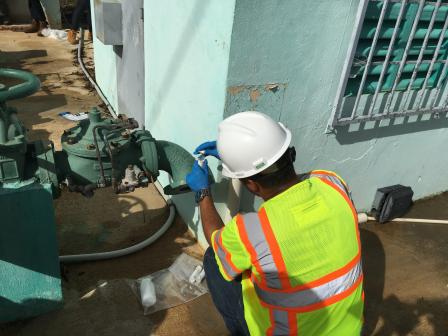News Releases from Headquarters›Office of the Administrator (AO)
EPA Hurricane Maria Update for Tuesday, October 31
WASHINGTON (October 31, 2017) — The U.S. Environmental Protection Agency (EPA) continues its round-the-clock response to Hurricanes Maria and Irma in close coordination with federal, commonwealth, territory, and local partners. EPA remains focused on environmental impacts and potential threats to human health as well as the safety of those in the affected areas.
Dorado Groundwater Contamination Superfund Site
EPA water sample results show there are no exceedances of drinking water standards at the Dorado Groundwater Superfund site in Puerto Rico. The agency tested water from spigots located near groundwater wells at the site to determine if contaminants previously found in the groundwater below the site, volatile organic compounds, were present.
EPA also tested for bacteria, as flood waters can carry E. coli, fecal coliform, and other microbial contaminants into surface waters and wells. The microbial tests came back negative, showing no microbial contamination. Nitrate and nitrite samples, which can be an indicator of runoff from fertilizer use and leaks from septic tanks and sewage systems, were also below drinking water standards.
Due to reports that residents were using water from spigots near wells on the Superfund site, EPA conducted an investigation that determined the water was originating from a drinking water system, not from Superfund site wells. EPA conducted additional sampling to determine if the water people had been using posed a health concern. The agency re-sampled water at three locations in the western portion of the site, where there were fences and warning signs, and two locations in the eastern portion of the site, near the Santa Rosa and Nevarez wells. These two wells have not historically shown contamination in excess of drinking water standards and are sometimes used by the Puerto Rico Aqueduct and Sewer Authority (PRASA) to provide drinking water to people in the community. PRASA and the Puerto Rico Department of Health sample these two wells regularly to check for chemical and bacteria contamination, and EPA sampled them to complement the Puerto Rico government’s efforts.
 Water sampling conducted in Dorado, Puerto Rico.
Water sampling conducted in Dorado, Puerto Rico.
Personnel
EPA continues to deploy personnel to Puerto Rico and the U.S. Virgin Islands as conditions allow. As of October 30, 2017:
• About 328 personnel are currently involved in hurricane response efforts.
• About 71 personnel are on the ground in USVI to assist with response efforts.
• About 156 personnel are on the ground in Puerto Rico to assist with response efforts.
Marine Operations
EPA is working with the U.S. Coast Guard on marine operations to assess sunken vessels around Puerto Rico and the USVI. Teams will locate and evaluate the condition of sunken vessels and assist with the disposal of recovered oil and hazardous materials. Approximately 726 vessels have been verified from field teams.
Assessment of Superfund Sites, Oil Sites and Regulated Facilities
EPA has completed preliminary assessments at all accessible EPA-led Superfund sites, oil sites, and chemical facilities in both Puerto Rico and the USVI to determine if the sites were affected by Hurricane Maria, and is conducting follow-up actions, such as fence and structure repairs. In addition, EPA is coordinating with the lead federal agencies for two other sites, Culebra and Vieques.
EPA teams have assessed 240 fixed facilities in Puerto and 65 in the USVI that are regulated under the Risk Management Plan (RMP), Facility Response Plan (FRP), or Spill Prevention, Control, and Countermeasure (SPCC) programs.
Debris Management
EPA continues to work with FEMA, the U.S. Army Corps of Engineers, and the Puerto Rico and USVI governments on an overall debris management strategy to keep hazardous waste out of the environment while maximizing recycling efforts by segregating debris piles and minimizing the amount of waste going to landfills. EPA is assisting with the handling and disposal of household hazardous waste, medical waste, e-waste, and orphan containers, which include drums, tanks, fluid totes, canisters, cylinders and similar containers displaced by the hurricane found floating in or washed up near waterways. EPA plans to conduct air monitoring at collection areas and during all hazardous materials operations.
Drinking Water and Wastewater Management
EPA is continuing to coordinate with government agencies in Puerto Rico and the USVI to assess the conditions of drinking water, which includes sampling, analysis and lab support, and getting wastewater treatment systems up and running. PRASA and the Puerto Rico Department of Health continue to monitor drinking water quality to assure that PRASA’s drinking water supplies meet local and federal drinking water standards.
Water Safety
According to the Centers for Disease Control and Prevention (CDC), people should not use the water from rivers, streams and coastal water to drink, bathe, wash, or cook with, unless first boiling this water for a minimum of one minute. If boiling the water is not possible, water may be disinfected with bleach. To learn more about making water safe in an emergency, go to CDC’s Making Water Safe in an Emergency web page.
For information and updates, visit: www.epa.gov/hurricane-maria.
